Amaranthaceae
| Amaranthaceae | |
|---|---|

| |
| Amaranthus retroflexus | |
| Scientific classification | |
| Kingdom: | Plantae |
| Clade: | Tracheophytes |
| Clade: | Angiosperms |
| Clade: | Eudicots |
| Order: | Caryophyllales |
| Family: | Amaranthaceae Juss. |
| Type genus | |
Amaranthus
| |
| Subfamilies | |
| Synonyms[1] | |
|
Chenopodiaceae Vent. | |
Amaranthaceae (
Description
Vegetative characters
Most species in the Amaranthaceae are
The leaves are simple and mostly alternate, sometimes opposite. They never possess stipules. They are flat or terete, and their shape is extremely variable, with entire or toothed margins. In some species, the leaves are reduced to minute scales. In most cases, neither basal nor terminal aggregations of leaves occur.[3]
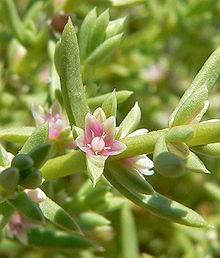
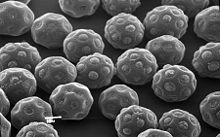
Inflorescence and flowers
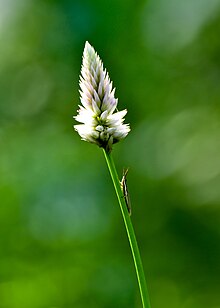
The
Fruits and seeds
The
Chromosome number
The basic chromosome number is (rarely 6) mostly 8–9 (rarely 17).[3]
Phytochemistry
Widespread in the Amaranthaceae is the occurrence of betalain pigments. The former Chenopodiaceae often contain isoflavonoids.[3]
In phytochemical research, several
Photosynthesis pathway
Although most of the family use the more common
The multiple origin of C4 photosynthesis in the Amaranthaceae is regarded as an evolutionary response to inexorably decreasing atmospheric CO2 levels, coupled with a more recent permanent shortage in water supply as well as high temperatures. Species that use water more efficiently had a selective advantage and were able to spread out into arid habitats.[5]
Distribution
Amaranthaceae is a widespread and
Economic importance
Some species, such as
A number of species are popular garden
Systematics

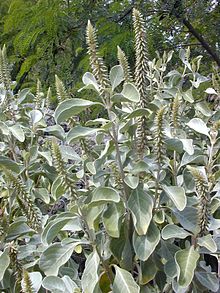




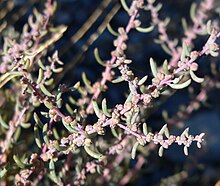
In the
The family Amaranthaceae was first published in 1789 by Antoine Laurent de Jussieu in Genera Plantarum, p. 87–88. The first publication of family Chenopodiaceae was in 1799 by Étienne Pierre Ventenat in Tableau du Regne Vegetal, 2, p. 253. The older name has priority and is now the valid scientific name of the extended Amaranthaceae (s.l. = sensu lato).
Some publications still continued to use the family name Chenopodiaceae.
Amaranthaceae Juss. (s.l.) includes the former families Achyranthaceae Raf., Atriplicaceae Durande, Betaceae Burnett, Blitaceae T.Post & Kuntze, Celosiaceae Martynov, Chenopodiaceae Vent. nom. cons., Corispermaceae Link, Deeringiaceae J.Agardh, Dysphaniaceae (Pax) Pax nom. cons., Gomphrenaceae Raf., Polycnemaceae Menge, Salicorniaceae Martynov, Salsolaceae Menge, and Spinaciaceae Menge.
The systematics of Amaranthaceae are the subject of intensive recent research. Molecular genetic studies revealed the traditional classification, based on morphological and anatomical characters, often did not reflect the phylogenetic relationships.
The former Amaranthaceae (in their narrow circumscription) are classified into two subfamilies,
Current studies classified the species of former Chenopodiaceae to eight distinct subfamilies (the research is not yet completed):
Genera
183 genera are accepted.[19] A short synoptic list of genera is given here. For further and more detailed information, see the subfamily pages.
References
- ^ "Tropics: Amaranthaceae Juss. – synonyms". 2018. Retrieved 2018-06-16.
- .
- ^ a b c d e f g The family Amaranthaceae at APWebsite.
- ^ a b c d e Kai Müller, Thomas Borsch (2005): Phylogenetics of Amaranthaceae using matK/trnK sequence data – evidence from parsimony, likelihood and Bayesian approaches. - Annals of the Missouri Botanical Garden, 92, p. 66-102.
- ^ a b c Gudrun Kadereit, Thomas Borsch, Kurt Weising, Helmut Freitag (2003): Phylogeny of Amaranthaceae and Chenopodiaceae and the evolution of C4 photosynthesis. - International Journal of Plant Sciences, Volume 164 (6), p.959–986.
- ^ List of allergic plants in family Chenopodiaceae at pollenlibrary.com
- doi:10.1111/boj.12385.

- ^ Judd et al. (2008). Plant Systematics: A Phylogenetic Approach, Third Edition. Sinauer Associates, Inc. Sunderland, MA
- ^ a b Hossein Akhani, Gerald Edwards, Eric H. Roalson (2007): Diversification Of The Old World Salsoleae s.l. (Chenopodiaceae): Molecular Phylogenetic Analysis Of Nuclear And Chloroplast Data Sets And A Revised Classification. - International Journal of Plant Sciences, 168(6), p.931–956.
- ^ a b G. Kadereit, S. Hohmann, J.W. Kadereit (2006): A synopsis of Chenopodiaceae subfam. Betoideae and notes on the taxonomy of Beta. - Willdenowia 36, p.9-19.
- ^ a b Gudrun Kadereit, Ladislav Mucina, Helmut Freitag (2006): Phylogeny of Salicornioideae (Chenopodiaceae): diversification, biogeography, and evolutionary trends in leaf and flower morphology. - Taxon 55(3), p. 617–642.
- ^ Maxim V. Kapralov, Hossein Akhani, Elena V. Voznesenskaya, Gerald Edwards, Vincent Franceschi, Eric H. Roalson (2006): Phylogenetic Relationships in the Salicornioideae / Suaedoideae / Salsoloideae s.l. (Chenopodiaceae) Clade and a Clarification of the Phylogenetic Position of Bienertia and Alexandra Using Multiple DNA Sequence Datasets. - Systematic Botany.
- ^ a b Gudrun Kadereit, Evgeny V. Mavrodiev, Elizabeth H. Zacharias, Alexander P. Sukhorukov (2010): Molecular phylogeny of Atripliceae (Chenopodioideae, Chenopodiaceae): Implications for systematics, biogeography, flower and fruit evolution, and the origin of C4 Photosynthesis. - American Journal of Botany 97(10), p. 1664-1687.
- ^ a b Gudrun Kadereit, Helmut Freitag (2011): Molecular phylogeny of Camphorosmeae (Camphorosmoideae, Chenopodiaceae): Implications for biogeography, evolution of C4-photosynthesis and taxonomy. - Taxon 60(1), p. 51-78
- ^ Ivonne Sánchez del-Pino, Thomas Borsch, Timothy J. Motle (2009): trnL-F and rpl16 Sequence Data and Dense Taxon Sampling Reveal Monophyly of Unilocular Anthered Gomphrenoideae (Amaranthaceae) and an Improved Picture of Their Internal Relationships. - Systematic Botany, Volume 34 (1), p. 57-67.
- ^ Rüdiger Masson & Gudrun Kadereit (2013): Phylogeny of Polycnemoideae (Amaranthaceae): Implications for biogeography, character evolution and taxonomy. Taxon 62 (1): 100-111. [1]
- ^ Alexander P. Sukhorukov (2007): Fruit anatomy and its taxonomic significance in Corispermum (Corispermoideae, Chenopodiaceae). – Willdenowia 37,
- ^ Peter Schütze, Helmut Freitag, Kurt Weising (2003): An integrated molecular and morphological study of the subfamily Suaedoideae Ulbr. (Chenopodiaceae). - Plant Systematics and Evolution, Volume 239, p. 257-286. abstract:
- ^ Amaranthaceae Juss. Plants of the World Online. Retrieved 3 April 2024.
- ^ doi:10.12705/661.6.
External links
 Media related to Amaranthaceae at Wikimedia Commons
Media related to Amaranthaceae at Wikimedia Commons Data related to Amaranthaceae at Wikispecies
Data related to Amaranthaceae at Wikispecies- The family Amaranthaceae at APWebsite.
- Genera of Amaranthaceae at Germplasm Resources Information Network (USDA)
- "Amaranthaceae". Integrated Taxonomic Information System.
- "Amaranthaceae". National Center for Biotechnology Information (NCBI).
- Amaranthaceae at Tropicos
- Amaranthaceae in BoDD – Botanical Dermatology Database
- IUCN link: Amaranthaceae threatened species
- Stanley L. Welsh, Clifford W. Crompton & Steven E. Clemants (2003): Chenopodiaceae in Flora of North America
- Kenneth R. Robertson & Steven E. Clemants (2003): Amaranthaceae in Flora of North America
- Gelin Zhu, Sergei L. Mosyakin & Steven E. Clemants (2003): Chenopodiaceae in Flora of China
- Bojian Bao, Thomas Borsch & Steven E. Clemants (2003): Amaranthaceae in Flora of China
